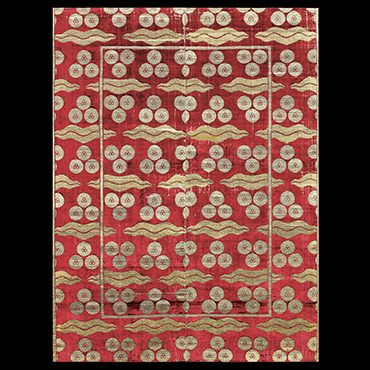Velvet with a heroic pattern
On this striking panel, the velvet has been decorated with rows of çintamani motifs, comprising two wavy lines below a pyramid of three circles. Silver thread was wrapped around ivory silk to give a silvery color to the circles, while gilded thread wound around yellow silk was used to endow a golden color to the wavy lines.
The çintamani pattern was a favorite design at the Ottoman court. In the Islamic world—where its elements appeared under the Timurids of 9th century AH/15th-century CE Central Asia and Iran—the circles were interpreted as leopard spots and the wavy lines as tiger stripes. The design was directly linked to the dress of heroes, such as Rustam, the great champion of the Persian epic the Shahnama, who wore a spotted leopard-skin helmet and striped tiger-skin coat. Çintamani is known on velvets from the 9th century AH/15th century CE onwards and the design was also found on a wide range of media and object types, including ceramic vessels, tiles, and inlaid woodwork.
The main center for the Ottoman textile industry was the city of Bursa in western Anatolia, an important international trade hub with a profitable market in raw silk and locally manufactured textiles. Amongst Bursa’s most prestigious textiles were the velvets woven with precious metal thread known as çatma. These velvets were generally used for furnishings, whether as table or bench covers, hangings, or even cushion covers. The importance of these textiles is shown not only through surviving examples, but also through their appearance in court registers and miniature painting of the period. Retaining its opulent colors and the rich depth of its original pile, this panel allows a rare view into the heights of 10th-century AH/16th-century CE luxury.
Velvet panel
Bursa, Türkiye, second half 10th century AH/16th century CE
Silk pile, silver and silver-gilt wrapped silk thread, h. 162 × w. 120 cm
The Al Thani Collection, ATC891

